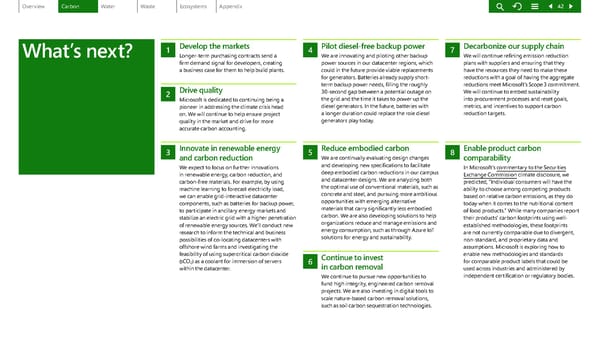What’s next? 1 Develop the markets Longer-term purchasing contracts send a firm demand signal for developers, creating a business case for them to help build plants. 2 Drive quality Microsoft is dedicated to continuing being a pioneer in addressing the climate crisis head on. We will continue to help ensure project quality in the market and drive for more accurate carbon accounting. 3 Innovate in renewable energy and carbon reduction We expect to focus on further innovations in renewable energy, carbon reduction, and carbon-free materials. For example, by using machine learning to forecast electricity load, we can enable grid-interactive datacenter components, such as batteries for backup power, to participate in ancillary energy markets and stabilize an electric grid with a higher penetration of renewable energy sources. We’ll conduct new research to inform the technical and business possibilities of co-locating datacenters with offshore wind farms and investigating the feasibility of using supercritical carbon dioxide (sCO 2 ) as a coolant for immersion of servers within the datacenter. 4 Pilot diesel-free backup power We are innovating and piloting other backup power sources in our datacenter regions, which could in the future provide viable replacements for generators. Batteries already supply short- term backup power needs, filling the roughly 30-second gap between a potential outage on the grid and the time it takes to power up the diesel generators. In the future, batteries with a longer duration could replace the role diesel generators play today. 5 Reduce embodied carbon We are continually evaluating design changes and developing new specifications to facilitate deep embodied carbon reductions in our campus and datacenter designs. We are analyzing both the optimal use of conventional materials, such as concrete and steel, and pursuing more ambitious opportunities with emerging alternative materials that carry significantly less embodied carbon. We are also developing solutions to help organizations reduce and manage emissions and energy consumption, such as through Azure IoT solutions for energy and sustainability. 6 Continue to invest in carbon removal We continue to pursue new opportunities to fund high integrity, engineered carbon removal projects. We are also investing in digital tools to scale nature-based carbon removal solutions, such as soil carbon sequestration technologies. 7 Decarbonize our supply chain We will continue refining emission reduction plans with suppliers and ensuring that they have the resources they need to make these reductions with a goal of having the aggregate reductions meet Microsoft’s Scope 3 commitment. We will continue to embed sustainability into procurement processes and reset goals, metrics, and incentives to support carbon reduction targets. 8 Enable product carbon compara b ility In Microsoft’s commentary to the Securities Exchange Commission climate disclosure, we predic ted, “Individual consumers will have the ability to choose among competing products based on relative carbon emissions, as they do today when it comes to the nutritional content of food products.” While many companies report their products’ carbon footprints using well- established methodologies, these footprints are not currently comparable due to divergent, non-standard, and proprietary data and assumptions. Microsoft is exploring how to enable new methodologies and standards for comparable product labels that could be used across industries and administered by independent certification or regulatory bodies. 42
 Environmental Sustainability Report | Microsoft Page 41 Page 43
Environmental Sustainability Report | Microsoft Page 41 Page 43